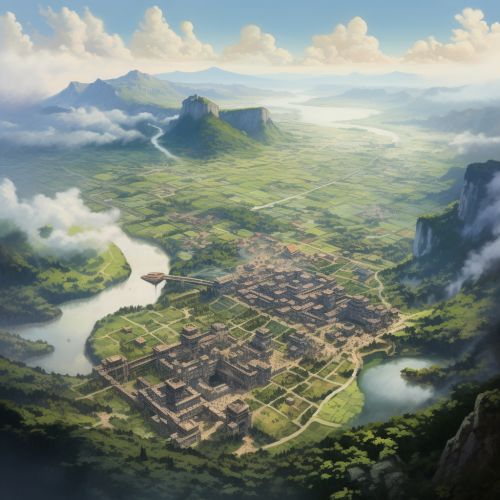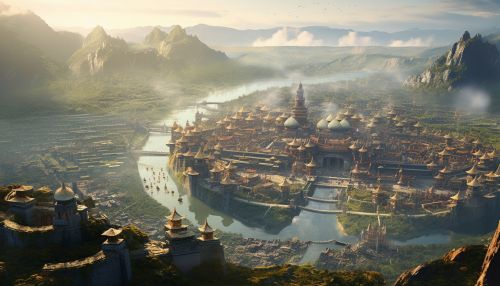Chu (state)
History
The state of Chu was one of the most prominent states during the Zhou dynasty period of ancient China. It was located in the middle reaches of the Yangtze river and south of the Huai river. The state of Chu was known for its powerful military, rich culture, and its significant influence on the other states during the Spring and Autumn and Warring States periods.


Origins and Early History
The origins of the state of Chu can be traced back to the early Zhou dynasty. The rulers of Chu were initially recognized as viscounts by the Zhou kings and were given the task of defending the southern frontier of the Zhou realm. Over time, the Chu state expanded its territory and increased its power, eventually declaring itself a kingdom in defiance of the Zhou authority.
Expansion and Power
During the Spring and Autumn period, Chu emerged as one of the most powerful states in China. Its geographical location provided it with abundant resources and strategic advantages, allowing it to expand its territory and influence. The Chu state was known for its strong military, which was often used to exert its influence over the other states and to expand its territory.
Culture and Influence
The state of Chu had a rich and unique culture, which had a significant influence on the other states and on the overall culture of ancient China. The Chu culture was known for its distinct music, poetry, and art, which were often characterized by their emotional depth and aesthetic appeal. The Chu Ci, also known as the Songs of Chu, is a collection of poetry from the state of Chu that has had a lasting impact on Chinese literature.
Decline and Fall
Despite its power and influence, the state of Chu eventually fell during the Warring States period. The decline of Chu was due to a combination of internal strife, external threats, and the rise of the Qin dynasty. The fall of Chu marked the end of one of the most powerful and influential states in ancient China.
Government and Politics
The state of Chu had a complex and well-structured government system. The king was the supreme ruler of the state, and he was assisted by a council of ministers and officials. The Chu government was known for its bureaucracy, which was divided into various departments and offices, each responsible for a specific area of administration.
Administration
The Chu state was divided into provinces, each governed by a provincial governor appointed by the king. The provinces were further divided into counties, each headed by a county magistrate. This hierarchical system of administration allowed the Chu government to effectively manage its vast territory and diverse population.
Military
The military was a crucial part of the Chu state. The Chu military was known for its strength and discipline, and it played a key role in the state's expansion and defense. The military was divided into various units, each with its own specific role and function. The Chu military was also known for its innovative tactics and strategies, which often gave it an edge in battles.
Economy
The economy of the Chu state was largely based on agriculture, with rice being the primary crop. The fertile lands along the Yangtze and Huai rivers provided ideal conditions for rice cultivation. In addition to agriculture, the Chu economy also relied on trade, crafts, and mining.
Agriculture
Rice cultivation was the mainstay of the Chu economy. The state had a well-developed system of irrigation and water management, which facilitated rice farming. Other crops such as millet, wheat, and barley were also grown in the state.
Trade
The Chu state had an extensive trade network, both within the state and with the other states. The state was known for its production of silk, lacquerware, and bronze goods, which were traded for other goods and resources. The Yangtze and Huai rivers served as important trade routes, facilitating the movement of goods and people.
Crafts and Mining
The Chu state was known for its skilled craftsmen, who produced a variety of goods such as silk textiles, lacquerware, and bronze vessels. The state was also rich in mineral resources, and mining was a significant part of the Chu economy. The Chu state was particularly known for its production of copper and iron.
Culture
The culture of the Chu state was distinct and rich, characterized by its unique music, poetry, and art. The Chu culture had a significant influence on the overall culture of ancient China, and it continues to be studied and appreciated today.
Music and Poetry
The music and poetry of the Chu state were known for their emotional depth and aesthetic appeal. The Chu Ci, or Songs of Chu, is a collection of poetry that reflects the distinctive culture and sentiments of the Chu people. The music of Chu, often accompanied by dance, was known for its rhythmic complexity and expressive melodies.
Art
The art of the Chu state was characterized by its intricate designs and vibrant colors. The Chu artists were known for their skill in bronze casting, lacquerware, and silk painting. The art of Chu often depicted scenes from nature, mythology, and everyday life, reflecting the beliefs and values of the Chu people.
